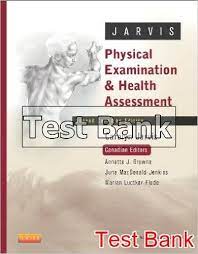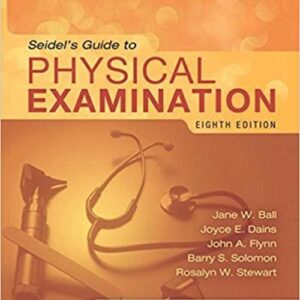Test Bank For Bates’ Guide to Physical Examination and History Taking 12th Edition Bickley
Chapter 1: Foundations for Clinical Proficiency
Multiple Choice
1. For which of the following patients would a comprehensive health history be appropriate?
A) A new patient with the chief complaint of “I sprained my ankle”
B) An established patient with the chief complaint of “I have an upper respiratory infection”
C) A new patient with the chief complaint of “I am here to establish care”
D) A new patient with the chief complaint of “I cut my hand”
Ans: C
Chapter: 01
Page and Header: 4, Patient Assessment: Comprehensive or Focused
Feedback: This patient is here to establish care, and because she is new to you, a
comprehensive health history is appropriate.
2. The components of the health history include all of the following except which one?
A) Review of systems
B) Thorax and lungs
C) Present illness
D) Personal and social items
Ans: B
Chapter: 01
Feedback: The thorax and lungs are part of the physical examination, not part of the health
history. The others answers are all part of a complete health history.
3. Is the following information subjective or objective?
Mr. M. has shortness of breath that has persisted for the past 10 days; it is worse with activity
and relieved by rest.
A) Subjective
B) Objective
Ans: A
Chapter: 01
Feedback: This is information given by the patient about the circumstances of his chief
complaint. It does not represent an objective observation by the examiner.
4. Is the following information subjective or objective?
Mr. M. has a respiratory rate of 32 and a pulse rate of 120.
A) Subjective
B) Objective
Ans: B
Chapter: 01
Feedback: This is a measurement obtained by the examiner, so it is considered objective data.
The patient is unlikely to be able to give this information to the examiner.
5. The following information is recorded in the health history: “The patient has had abdominal
pain for 1 week. The pain lasts for 30 minutes at a time; it comes and goes. The severity is 7 to 9
on a scale of 1 to 10. It is accompanied by nausea and vomiting. It is located in the
mid-epigastric area.”
Which of these categories does it belong to?
A) Chief complaint
B) Present illness
C) Personal and social history
D) Review of systems
Ans: B
Chapter: 01
Feedback: This information describes the problem of abdominal pain, which is the present
illness. The interviewer has obtained the location, timing, severity, and associated manifestations
of the pain. The interviewer will still need to obtain information concerning the quality of the
pain, the setting in which it occurred, and the factors that aggravate and alleviate the pain. You
will notice that it does include portions of the pertinent review of systems, but because it relates
directly to the complaint, it is included in the history of present illness.
6. The following information is recorded in the health history: “The patient completed 8th
grade. He currently lives with his wife and two children. He works on old cars on the weekend.
He works in a glass factory during the week.”
Which category does it belong to?
A) Chief complaint
B) Present illness
C) Personal and social history
D) Review of systems
Ans: C
Chapter: 01
Feedback: Personal and social history information includes educational level, family of origin,
current household status, personal interests, employment, religious beliefs, military history, and
lifestyle (including diet and exercise habits; use of alcohol, tobacco, and/or drugs; and sexual
preferences and history). All of this information is documented in this example.
7. The following information is recorded in the health history: “I feel really tired.”
Which category does it belong to?
A) Chief complaint
B) Present illness
C) Personal and social history
D) Review of systems
Ans: A
Chapter: 01
Feedback: The chief complaint is an attempt to quote the patient’s own words, as long as they
are suitable to print. It is brief, like a headline, and further details should be sought in the present
illness section. The above information is a chief complaint.
8. The following information is recorded in the health history: “Patient denies chest pain,
palpitations, orthopnea, and paroxysmal nocturnal dyspnea.”
Which category does it belong to?
A) Chief complaint
B) Present illness
C) Personal and social history
D) Review of systems
Ans: D
Chapter: 01
Feedback: Review of systems documents the presence or absence of common symptoms
related to each major body system. The absence of cardiac symptoms is listed in the above
example.
9. The following information is best placed in which category?
“The patient has had three cesarean sections.”
A) Adult illnesses
B) Surgeries
C) Obstetrics/gynecology
D) Psychiatric
Ans: B
Chapter: 01
Feedback: A cesarean section is a surgical procedure. Approximate dates or the age of the
patient at the time of the surgery should also be recorded.
10. The following information is best placed in which category?
“The patient had a stent placed in the left anterior descending artery (LAD) in 1999.”
A) Adult illnesses
B) Surgeries
C) Obstetrics/gynecology
D) Psychiatric
Ans: A
Chapter: 01
Feedback: The adult illnesses category is reserved for chronic illnesses, significant
hospitalizations, significant injuries, and significant procedures. A stent is a major procedure but
does not involve a surgeon.
11. The following information is best placed in which category?
“The patient was treated for an asthma exacerbation in the hospital last year; the patient has
never been intubated.”
A) Adult illnesses
B) Surgeries
C) Obstetrics/gynecology
D) Psychiatric
Ans: A
Chapter: 01
Feedback: This is information about a significant hospitalization and should be placed in the adult illnesses section. If the patient is being seen for an asthma exacerbation, you may
consider placing this information in the present illness section, because it relates to the chief
complaint at that visit.




